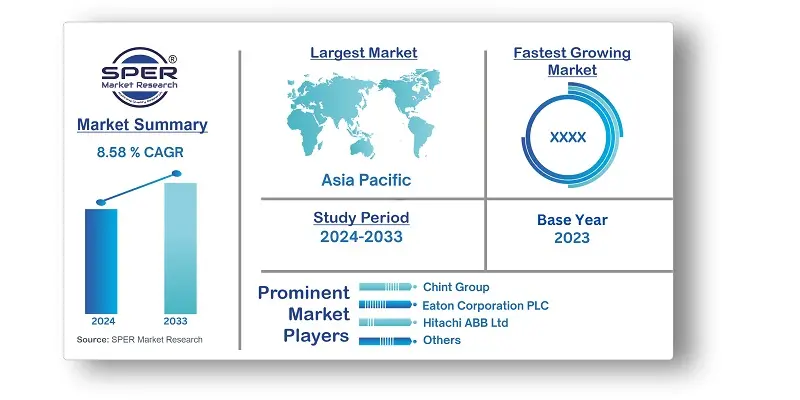
Asia Pacific Medium Voltage Switchgear Market Growth, Size, Trends, Share and Future Outlook
Asia Pacific Medium Voltage Switchgear Market Size- By Voltage, By Component, By Insulation, By End User- Regional Outlook, Competitive Strategies and Segment Forecast to 2033
| Published: May-2024 | Report ID: POAE2435 | Pages: 1 - 153 | Formats*: |
| Category : Power & Energy | |||
- ABB opened a new factory in Vietnam in September 2022 with the goal of producing more medium-voltage switchgear. The manufacturing hub will use production lines designed and constructed based on the tried-and-true lean manufacturing techniques utilized in the company's European facilities to produce 700 units of plug-and-play modular power distribution systems and 2,000 panels of ABB's UniGear Medium Voltage Switchgear annually.
- March 2022: Using Nuventura's dry air technology, Aktif Elektroteknik and Nuventura collaborated to design and produce SF6-free primary, gas-insulated switchgear (GIS) in Turkey. In addition to producing the goods, Aktif will offer its clients maintenance and post-purchase servicing.


| Report Metric | Details |
| Market size available for years | 2020-2033 |
| Base year considered | 2023 |
| Forecast period | 2024-2033 |
| Segments covered | By Voltage, By Component, By Insulation, By End User |
| Regions covered | India, Japan, China, Rest of Asia Pacific |
| Companies Covered | Bharat Heavy Electricals Limited, Chint Group, Eaton Corporation PLC, General Electric Company, Hitachi ABB Ltd., Hyosung Heavy Industries Corp., Lucy Group Ltd., Mitsubishi Electric Corporation, Powell Industries Inc., Schneider Electric SE, Siemens Energy AG, Toshiba Corp., Others |
- Restaurants and Food Service Providers
- Retailers and Grocery Chains
- Seafood Distributors and Wholesalers
- Importers and Exporters
- Seafood Processing Companies
- Aquaculture Farms
- Government Regulatory Bodies
- Consumers and Household Buyers
- Tourism and Hospitality Industry
| By Voltage: |
|
| By Component: |
|
| By Insulation: |
|
| By End User: |
|
- Asia Pacific Medium Voltage Switchgear Market Size (FY’2024-FY’2033)
- Overview of Asia Pacific Medium Voltage Switchgear Market
- Segmentation of Asia Pacific Medium Voltage Switchgear Market By Voltage (3kV to 12kV, 12kV to 24kV, 24kV to 36kV)
- Segmentation of Asia Pacific Medium Voltage Switchgear Market By Component (Circuit Breakers, Contactors, Switches & Disconnector, Fuses)
- Segmentation of Asia Pacific Medium Voltage Switchgear Market By Insulation (Air Insulation Switchgear, Gas Insulation Switchgear, Others)
- Expansion Analysis of Asia Pacific Medium Voltage Switchgear Market
- Problems and Obstacles in Asia Pacific Medium Voltage Switchgear Market
- Competitive Landscape in the Asia Pacific Medium Voltage Switchgear Market
- Impact of COVID-19 and Demonetization on Asia Pacific Medium Voltage Switchgear Market
- Details on Current Investment in Asia Pacific Medium Voltage Switchgear Market
- Competitive Analysis of Asia Pacific Medium Voltage Switchgear Market
- Prominent Players in the Asia Pacific Medium Voltage Switchgear Market
- SWOT Analysis of Asia Pacific Medium Voltage Switchgear Market
- Asia Pacific Medium Voltage Switchgear Market Future Outlook and Projections (FY’2024-FY’2033)
- Recommendations from Analyst
1.1. Scope of the report1.2. Market segment analysis
2.1. Research data source2.1.1. Secondary Data2.1.2. Primary Data2.1.3. SPER’s internal database2.1.4. Premium insight from KOL’s2.2. Market size estimation2.2.1. Top-down and Bottom-up approach2.3. Data triangulation
4.1. Driver, Restraint, Opportunity and Challenges analysis4.1.1. Drivers4.1.2. Restraints4.1.3. Opportunities4.1.4. Challenges4.2. COVID-19 Impacts of the Asia Pacific Medium Voltage Switchgear Market
5.1. SWOT Analysis5.1.1. Strengths5.1.2. Weaknesses5.1.3. Opportunities5.1.4. Threats5.2. PESTEL Analysis5.2.1. Political Landscape5.2.2. Economic Landscape5.2.3. Social Landscape5.2.4. Technological Landscape5.2.5. Environmental Landscape5.2.6. Legal Landscape5.3. PORTER’s Five Forces5.3.1. Bargaining power of suppliers5.3.2. Bargaining power of buyers5.3.3. Threat of Substitute5.3.4. Threat of new entrant5.3.5. Competitive rivalry5.4. Heat Map Analysis
6.1. Asia Pacific Medium Voltage Switchgear Market Manufacturing Base Distribution, Sales Area, Product Type6.2. Mergers & Acquisitions, Partnerships, Product Launch, and Collaboration in Asia Pacific Medium Voltage Switchgear Market
7.1. Asia Pacific Medium Voltage Switchgear Market Size, Share and Forecast, By Voltage, 2020-20267.2. Asia Pacific Medium Voltage Switchgear Market Size, Share and Forecast, By Voltage, 2027-20337.3. 3kV to 12kV7.4. 12kV to 24kV7.5. 24kV to 36kV
8.1. Asia Pacific Medium Voltage Switchgear Market Size, Share and Forecast, By Component, 2020-20268.2. Asia Pacific Medium Voltage Switchgear Market Size, Share and Forecast, By Component, 2027-20338.3. Circuit Breakers8.4. Contactors8.5. Switches & Disconnector8.6. Fuses
9.1. Asia Pacific Medium Voltage Switchgear Market Size, Share and Forecast, By Insulation, 2020-20269.2. Asia Pacific Medium Voltage Switchgear Market Size, Share and Forecast, By Insulation, 2027-20339.3. Air Insulation Switchgear9.4. Gas Insulation Switchgear9.5. Others
10.1. Asia Pacific Medium Voltage Switchgear Market Size, Share and Forecast, By End User, 2020-202610.2. Asia Pacific Medium Voltage Switchgear Market Size, Share and Forecast, By End User, 2027-203310.3. Commercial & Residential10.4. Power Utilities10.5. Industrial Sector
11.1. Asia Pacific Medium Voltage Switchgear Market Size and Market Share
12.1. Asia Pacific Medium Voltage Switchgear Market Size and Market Share By Region (2020-2026)12.2. Asia Pacific Medium Voltage Switchgear Market Size and Market Share By Region (2027-2033)12.3. India12.4. Japan12.5. China12.6. Rest of Asia Pacific
13.1. Bharat Heavy Electricals Limited13.1.1. Company details13.1.2. Financial outlook13.1.3. Product summary13.1.4. Recent developments13.2. Chint Group13.2.1. Company details13.2.2. Financial outlook13.2.3. Product summary13.2.4. Recent developments13.3. Eaton Corporation PLC13.3.1. Company details13.3.2. Financial outlook13.3.3. Product summary13.3.4. Recent developments13.4. General Electric Company13.4.1. Company details13.4.2. Financial outlook13.4.3. Product summary13.4.4. Recent developments13.5. Hitachi ABB Ltd.13.5.1. Company details13.5.2. Financial outlook13.5.3. Product summary13.5.4. Recent developments13.6. Hyosung Heavy Industries Corp.13.6.1. Company details13.6.2. Financial outlook13.6.3. Product summary13.6.4. Recent developments13.7. Lucy Group Ltd.13.7.1. Company details13.7.2. Financial outlook13.7.3. Product summary13.7.4. Recent developments13.8. Mitsubishi Electric Corporation13.8.1. Company details13.8.2. Financial outlook13.8.3. Product summary13.8.4. Recent developments13.9. Powell industries Inc13.9.1. Company details13.9.2. Financial outlook13.9.3. Product summary13.9.4. Recent developments13.10. Schneider Electric SE13.10.1. Company details13.10.2. Financial outlook13.10.3. Product summary13.10.4. Recent developments13.11. Siemens Energy AG13.11.1. Company details13.11.2. Financial outlook13.11.3. Product summary13.11.4. Recent developments13.12. Toshiba Corp.13.12.1. Company details13.12.2. Financial outlook13.12.3. Product summary13.12.4. Recent developments13.13. Others
SPER Market Research’s methodology uses great emphasis on primary research to ensure that the market intelligence insights are up to date, reliable and accurate. Primary interviews are done with players involved in each phase of a supply chain to analyze the market forecasting. The secondary research method is used to help you fully understand how the future markets and the spending patterns look likes.
The report is based on in-depth qualitative and quantitative analysis of the Product Market. The quantitative analysis involves the application of various projection and sampling techniques. The qualitative analysis involves primary interviews, surveys, and vendor briefings. The data gathered as a result of these processes are validated through experts opinion. Our research methodology entails an ideal mixture of primary and secondary initiatives.



Frequently Asked Questions About This Report
PLACE AN ORDER
Year End Discount
Sample Report
Pre-Purchase Inquiry
NEED CUSTOMIZATION?
Request CustomizationCALL OR EMAIL US
100% Secure Payment






Related Reports
Our Global Clients
Our data-driven insights have influenced the strategy of 200+ reputed companies across the globe.




















